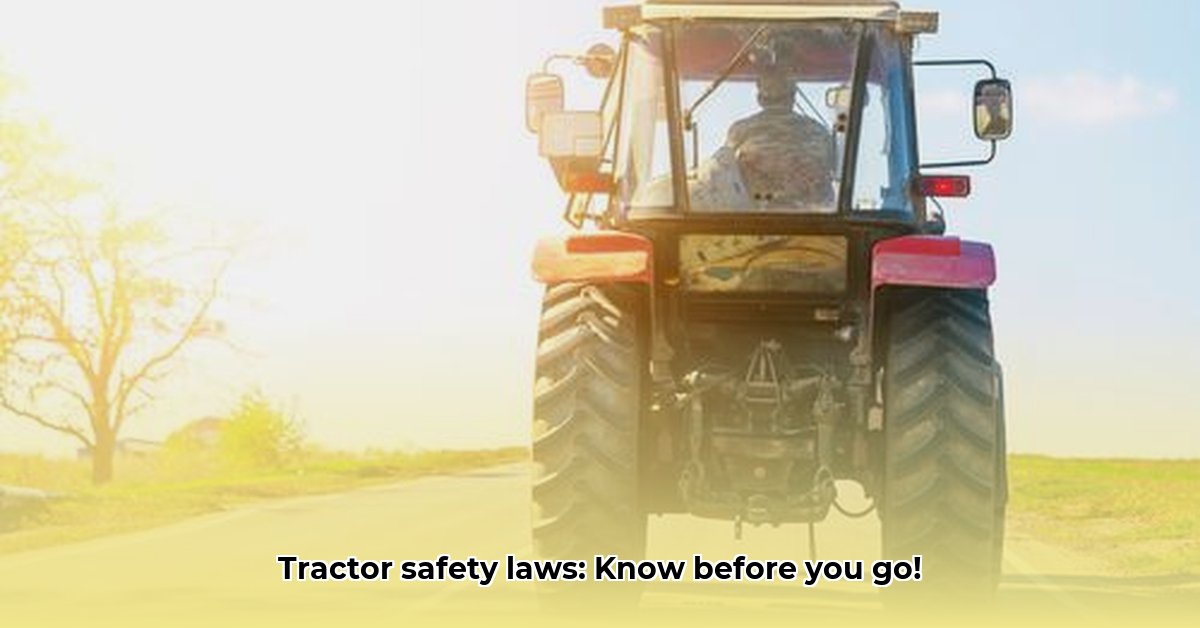
Driving a tractor on public roads is integral to modern agriculture, but navigating the legal and safety requirements can be challenging. This guide provides actionable steps and state-specific information to ensure both compliance and safety for farmers and other road users. For more detailed state-specific information, see this helpful resource.
Understanding State-Specific Regulations
State regulations governing tractor operation vary significantly. Key differences include lighting requirements, speed limits, and the mandatory use of the Slow-Moving Vehicle (SMV) emblem (the orange triangle). Ignoring these regulations can result in hefty fines and legal repercussions. Always consult your state's Department of Motor Vehicles (DMV) website for the most up-to-date and accurate information.
Note: The following table provides a general overview and is not exhaustive. Always verify information with your state's DMV.
| State | SMV Emblem Required? | Lighting Requirements | Speed Limits (mph) | Night Driving Restrictions | Additional Considerations |
|---|---|---|---|---|---|
| California | Yes | Headlights, taillights, turn signals, reflectors | Varies by roadway | Generally discouraged | Road type and location significantly impact specific requirements. |
| Texas | Yes | Similar to California; consult the Texas DMV website | Varies by roadway | Depends on local ordinances | County and municipal regulations may add further restrictions. |
| Illinois | Yes | Detailed specifications for lights and visibility | Varies by roadway | Generally discouraged | Ensure maximum visibility in low-light conditions. |
| Florida | Yes | Check the Florida DMV website for precise details | Varies by roadway | Depends on local ordinances | Be aware of local speed limits and regulations. |
| Iowa | Yes | Must meet minimum visibility standards | Varies by roadway | Highly discouraged | Consider using additional safety measures like flashing lights. |
| ... | ... | ... | ... | ... | ... |
Wouldn't it be easier if there were consistent national standards? Many advocate for this. Until then, diligent research is crucial for legal and safe operation.
Essential Safety Practices
Beyond legal compliance, proactive safety measures are paramount. Treat your tractor as a large, slow-moving vehicle sharing the road with faster traffic.
1. Pre-Trip Inspection: Before each journey, conduct a thorough inspection. Check lights, tires, brakes, and other vital systems. This proactive approach significantly mitigates the risk of mechanical failure.
2. Defensive Driving: Anticipate other drivers' actions. Assume they may not see you, particularly at night or in poor weather. Maintain a safe following distance and adjust your speed accordingly.
3. Signal Clearly and in Advance: Use turn signals well in advance of any lane changes or turns. This allows ample time for other vehicles to react safely.
4. Maintain a Safe Speed: Observe posted speed limits and drive at a speed appropriate for road and weather conditions. Reducing speed on curves, hills, or in adverse weather is essential for safety.
5. Enhance Tractor Visibility: To increase visibility, especially at night, consider adding extra lights or retro-reflective tape. This enhancement significantly improves your chances of being seen by other vehicles.
6. Be Aware of Blind Spots: Large vehicles like tractors have substantial blind spots. Use mirrors frequently and proceed cautiously near intersections and when merging onto roadways.
7. Monitor Weather Conditions: Check the weather forecast before departing. Poor weather significantly impairs visibility and makes driving conditions hazardous. Postpone your trip if necessary.
Risk Assessment and Mitigation
Operating a tractor on the road presents several risks. The following matrix details potential hazards and corresponding mitigation strategies.
| Risk | Likelihood | Severity | Mitigation |
|---|---|---|---|
| Night Driving | High | High | Avoid if possible. If unavoidable, use extra lights and drive at extremely reduced speeds. |
| Multi-Lane Road Driving | Medium | High | Exercise extreme caution; consider alternative routes if possible. |
| Inadequate Driver Training | High | High | Invest in professional training; it's a crucial investment in your personal safety. |
| Poor Weather Conditions | Medium | High | Postpone your trip if possible; if not, drive exceptionally cautiously. |
| Mechanical Failure | Medium | High | Regular maintenance is vital; promptly address any warning signs. |
| Driver Fatigue | Medium | High | Take frequent breaks and avoid driving when tired; prioritize safety. |
Insurance Considerations
Appropriate insurance coverage is crucial. Obtain liability and property damage insurance specific to agricultural vehicles.
Advocacy and Future Outlook
Farmers can contribute to improved road safety by supporting advocacy efforts for increased awareness and consistent national regulations. Contact your state representatives and express your support for national standardization.
Conclusion
Safe and legal tractor road operation requires a combination of legal awareness, defensive driving techniques, and a proactive approach to risk management. By adhering to these guidelines, farmers can significantly enhance their safety and contribute to a safer environment for everyone sharing the road.